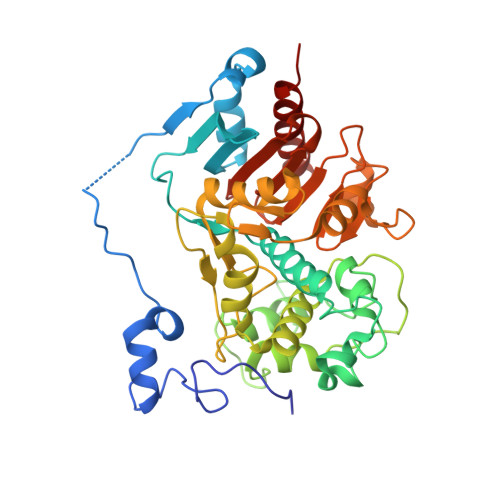Two alternative modes for optimizing nylon-6 byproduct hydrolytic activity from a carboxylesterase with a beta-lactamase fold: X-ray crystallographic analysis of directly evolved 6-aminohexanoate-dimer hydrolase.
Ohki, T., Shibata, N., Higuchi, Y., Kawashima, Y., Takeo, M., Kato, D., Negoro, S.(2009) Protein Sci 18: 1662-1673
- PubMed: 19521995
- DOI: https://doi.org/10.1002/pro.185
- Primary Citation of Related Structures:
2ZLY, 2ZM2, 2ZM8, 2ZM9 - PubMed Abstract:
Promiscuous 6-aminohexanoate-linear dimer (Ald)-hydrolytic activity originally obtained in a carboxylesterase with a beta-lactamase fold was enhanced about 80-fold by directed evolution using error-prone PCR and DNA shuffling. Kinetic studies of the mutant enzyme (Hyb-S4M94) demonstrated that the enzyme had acquired an increased affinity (K(m) = 15 mM) and turnover (k(cat) = 3.1 s(-1)) for Ald, and that a catalytic center suitable for nylon-6 byproduct hydrolysis had been generated. Construction of various mutant enzymes revealed that the enhanced activity in the newly evolved enzyme is due to the substitutions R187S/F264C/D370Y. Crystal structures of Hyb-S4M94 with bound substrate suggested that catalytic function for Ald was improved by hydrogen-bonding/hydrophobic interactions between the Ald--COOH and Tyr370, a hydrogen-bonding network from Ser187 to Ald--NH(3) (+), and interaction between Ald--NH(3) (+) and Gln27-O(epsilon) derived from another subunit in the homo-dimeric structure. In wild-type Ald-hydrolase (NylB), Ald-hydrolytic activity is thought to be optimized by the substitutions G181D/H266N, which improve an electrostatic interaction with Ald--NH(3) (+) (Kawashima et al., FEBS J 2009; 276:2547-2556). We propose here that there exist at least two alternative modes for optimizing the Ald-hydrolytic activity of a carboxylesterase with a beta-lactamase fold.
Organizational Affiliation:
Department of Materials Science and Chemistry, Graduate School of Engineering, University of Hyogo, Hyogo 671-2280, Japan.

















